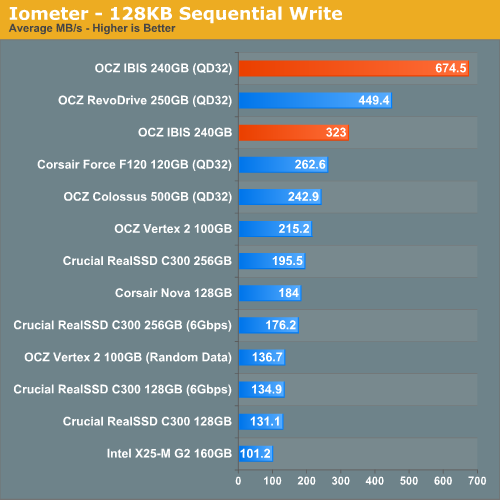OCZ's Fastest SSD, The IBIS and HSDL Interface Reviewed
by Anand Lal Shimpi on September 29, 2010 12:01 AM ESTHigh Queue Depth Sequential Performance, Just Amazing
Our default sequential write tests have a queue depth of 1, representative of what most desktop users would encounter. Our random write tests bump the queue depth up to 3, but not high enough to really stress a four drive SF-1200 RAID setup. What we’ve done here is provide performance results for the IBIS drive in our standard Iometer tests as well as at a queue depth of 32. The latter is only useful in showing you how performance can scale with very IO dependent workloads, while the former points out that this is probably overkill for a desktop user.
We’ll start with sequential performance. With our standard queue depth of 1, we can write to the IBIS at 323MB/s. That’s a 50% improvement over a standard 120GB SandForce based drive like the Vertex 2 or Corsair Force.

When we crank up the queue depth to 32 simulating a ton of sequential IO the performance gap grows tremendously. While standard SSDs are already limited by SATA at this point, the IBIS jumps to 675MB/s. That’s from a single HSDL port. A 4-way RAID of IBIS drives would deliver absolutely staggering performance assuming linear scaling.
Colossus owners will obviously feel very sad as a single SandForce drive comes close to outperforming the Colossus 500GB drive in this test. The IBIS just puts it to shame.

Sequential read speed is even more impressive. With a queue depth of 1 the IBIS was able to pull 372MB/s, a 77% increase over a single SandForce drive. Crank the queue depth up to 32 and our IBIS sample managed 804MB/s. Again, this is from a single HSDL channel, four of these in RAID-0 should be amazing.










74 Comments
View All Comments
punjabiplaya - Wednesday, September 29, 2010 - link
If I understood this correctly, OCZ is just using PCIe signaling over a SAS cable (with accompanying card to demux and pass on to the PCIe lanes)? That's ingenious.davecason - Wednesday, September 29, 2010 - link
This method also makes it easy to port it to a laptop interface through an express card socket.vol7ron - Wednesday, September 29, 2010 - link
Isn't that what PCIe RAID controllers do (minus the SAS cable)?TinyTeeth - Saturday, October 2, 2010 - link
I'm pretty sure they communicate with regular SATA SSD drives through the SATA interface, whereas HSDL brings PCIe all the way to the SSD drive. This would be why IBIS supports much higher IOPS than previous PCIe SSD solutions like the Z-Drive (which were limited by SATA RAID). Someone please correct me if I'm wrong about this.Ethaniel - Wednesday, September 29, 2010 - link
675 MB/s in sequential write? I just feel sad all of a sudden. SSDs are so forbidden for me right now, but this is a true monster. Maybe they'll make a more "down-to-Earth" version next time. Good stuff, anyway.vol7ron - Wednesday, September 29, 2010 - link
If only I could burn DVDs that fast.Lerianis - Saturday, October 2, 2010 - link
You still burn DVD's? Hell, I stopped doing that a few months ago when I realized that 99% of the stuff I burned was really a 'watch-once and never again' thing and went out to get one of those 2.5" 1TB external hard drives.Haven't burned another DVD since.
rqle - Wednesday, September 29, 2010 - link
too much proprietary peripherals, if i am going to use a PCIe card, I might as well just stick with a revodrive. pcie slots, proprietary slots connectors, proprietary cable, proprietary disk drive interface, blah. ill just stick with their own revodrive for now and wait for sata or sas controllers to pick up speed.jo-82 - Wednesday, September 29, 2010 - link
SAS cabels aren't that expensive these days, and the most companies who would by one of these use them today anyway.And good luck waiting the next 3-5 years or so for SATA 12GB ;)
vol7ron - Wednesday, September 29, 2010 - link
Gb, not GB